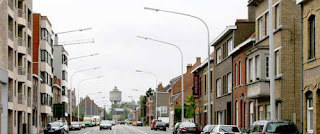Exercise 1
Point Placement
The first exercise was to use the Principle of Unequal Spacing to place points on a piece of graph paper. Krause says to use this principle and apply it to “points-of-interest” in later compositions. Placing various focal points in random spaces of compositions ensures that the work will be more pleasing to the eye.
Exercise 2
Horizon Variations
The second exercise dealt with cropping photos in order to alter the positioning of the horizon. Krause says to avoid centering the horizon line in an image unless it is for a certain reason.
In the first original image, there is a lot going on with the cars, trees, and telephone poles. We were told to crop the photo in order to draw a stronger focus on the road as opposed to the sky.
The image below is my edited version of the horizon photo. I used the crop tool in order to cut out as much of the sky as possible. I tried to cut off some of the tops of the telephone poles. I also made sure to follow Krause’s advice by placing the horizon higher rather than in the center of the image.
 |
| Focus on Road |
In the second original image, the horizon is placed directly in the center of the image and the intended focus is unclear.
 |
| Original Image 2 |
 |
| Focus on Sky |
I believe that my cropped images are much more pleasing to the eye and effectively show how the focus of an image may be changed using the crop tool.
Exercise 3
Golden Section Ruler
Krause explains the Golden Section as “an aesthetically pleasing division of space that is often used by artists as the basis for measurements within their compositions” (34). To the left is my Golden Section Ruler. I created a new canvas in Photoshop and then using the rectangle tool I drew a 13” long. I then divided the ruler in two sections, one 8” and one 5”. I separated the two by using the paint bucket tool and coloring one purple and the other pink. I will be able to insert this ruler into Photoshop as a layer in order to determine where to place focal points in future compositions.
